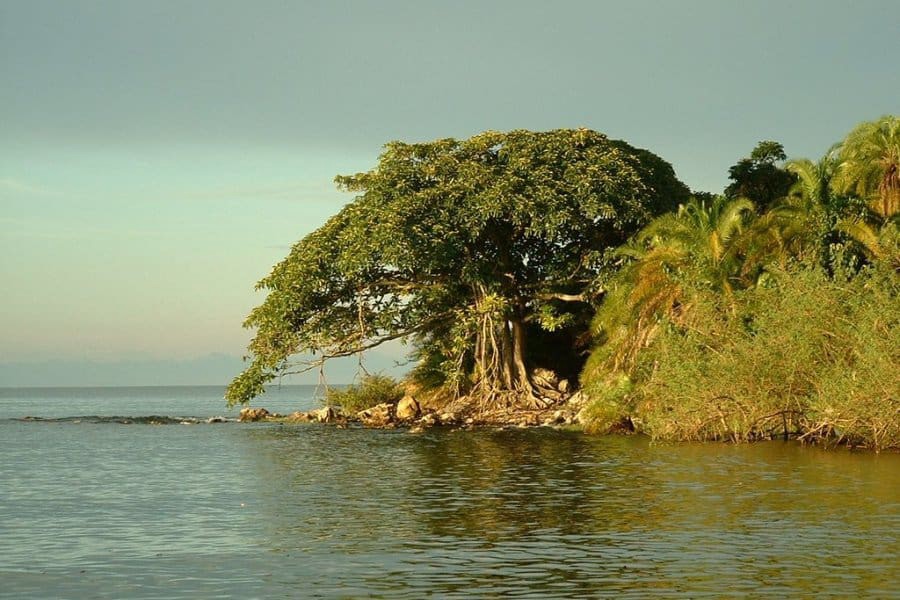Rubondo Island National Park
Rubondo Island National Park: Rubondo Island, an exemplary model of wildlife conservation, is situated southwest of Lake Victoria. With a length of 26 km and a width of up to 10 km, it is the largest island national park in Africa. The island’s pristine tropical rainforest encompasses almost 75% of its area. The island has served as a secure refuge for wild chimpanzees, sitatunga antelope, elephants, and giraffes since the 1960s. Rubondo, Africa’s largest island national park, offers an authentic Jurassic Park experience that deviates from conventional routes.

Rubondo Island National Park is located on an island in Lake Victoria, the world’s second-largest lake. Ninety percent of the island remains forested and uninhabited. This area is home to several indigenous wildlife, such as giraffes, elephants, antelopes, hippopotamuses, and crocodiles.
Visitors may respite from game viewing in the tranquil ambiance of a lakeside setting by exploring Rubondo Island National Park. Excursions are enhanced by the exploration of the park’s islands. The principal lodges can easily organize fishing excursions on Lake Victoria. Rubondo Island National Park offers a serene environment for exploring Lake Victoria and serves as a refreshing respite from the demanding safari circuit.
Rubondo, with its own airport, is accessible via Dar es Salaam, Zanzibar, Arusha, and the Serengeti. To merge this remote island retreat with an extraordinary gorilla experience in Rwanda’s Volcanoes National Park, guests may alternatively fly directly from Kigali.
Wildlife of Rubondo National Park
Rubondo Island features numerous uninhabited sandy beaches adjacent to a jungle. Bushbucks inhabit this region, moving quietly through the labyrinth of tamarind, palm, and sycamore fig trees. In this location, the aquatic sitatunga, characterized by its unique webbed feet and shaggy fur, is particularly visible near the water. The yellow-spotted otters inhabiting the island’s rocky bays predominantly consume tilapia (Oreochromis niloticus), whereas the carnivorous Nile perch in Rubondo Island National Park, weighing up to 100 kg, is a formidable challenge for eager anglers.
The forest hosts a diverse array of bright orchid species, wild jasmine, and an enigmatic blend of fragrances. The forest cover of the park is estimated to comprise 90% of its overall area. Adjacent to the lake, one can find papyrus groves and expansive meadows. Chimpanzees, black and white colobus monkeys, elephants, and giraffes coexist in this habitat with indigenous wildlife like as hippos, crocodiles, vervet monkeys, genets, and dik-dik.

Bird Watching Rubondo Island National Park
Rubondo National Park is teeming with avian species, rendering it a hidden gem for birdwatchers. Throughout the years, around 400 species have been recognized. Flocks of African gray parrots, once liberated on the island, soar exuberantly and vocalize in diverse tones. Herons, storks, and spoonbills breed abundantly in the swampy bank regions. Annually, thousands of migratory birds from Europe converge with them.
Attraction in Rubondo Island National Park
Diverse aquatic avifauna, migratory species from Eurasia, and introduced African grey parrots
African fish eagles are frequently observed in substantial quantities.
The diverse animal species include sitatunga, elephants, giraffes, hippos, bushbucks, pythons, crocodiles, chimpanzees (not fully habituated), bush pigs, and suni.
- -Lake Victoria, including its deepest point within the park, offers visitors a stunning vista.
- -A remarkable image of one of the final extant specimens of deep, evergreen lowland Congolese forest, characterized by a unique ecological mosaic and significant biological value.
- -Charming and renowned beaches, including Fly Catcher, Mchangani, and Michicoco.
- -The notable gulfs of Kamea and Irumo.
- -An unobstructed perspective of both the sunrise and sunset.
- -Cultural sites that illustrate the lifestyle of the indigenous peoples that once inhabited the area, including “Ntungamirwe,” “Maji Matakatifu,” “Altare,” and “Solo.”
Tourist Attraction in Rubondo Island National Park
Chimpanzee Habituation Encounter
The Rubondo Island Chimpanzee Habituation Experience offers guests the opportunity to engage in Professor Bernhard Grzimek’s Noah’s Ark Project, a hallmark of Rubondo Island Camp. In partnership with the Frankfurt Zoological Society, Grzimek reintroduced endangered species, comprising 16 West African chimpanzees, to Rubondo. Visitors can now embark on a guided walking safari into the pristine tropical forest to search for primates. In the prior year (2021), 92 percent of guests observed chimpanzees during their habituation experience. Since 2020, tourists have successfully observed chimpanzees at a distance of approximately 10-15 meters, with most encounters lasting a minimum of 30 minutes.
Trekking Chimpanzees
Rubondo Island features two areas for chimpanzee trekking. Depending on their location and visibility, you may need to undertake a game drive, a boat excursion, and subsequently proceed on foot to watch the chimpanzees. The chimpanzee habituation experience can occur at any time of the year, contingent upon food supply and climatic conditions. Due to the famed mobility of chimpanzees, visitors should possess a reasonable level of fitness and an adventurous spirit.
Note that the chimpanzee encounter is unsuitable for anybody unable to hike for around two hours on difficult terrain. While there is no guarantee that visitors will observe chimpanzees, attending during the dry season, from June to October, maximizes their likelihood of doing so. Note that the minimum age requirement is 12 and the maximum group size for each trek is 8.
Chimpanzees highly prioritize their familial relationships. They inhabit extended familial units including 20 to 120 individuals. They possess a fission-fusion social structure, periodically fragmenting into smaller, interchangeable groups. A group of chimpanzees in northern Rubondo Island, where over 30 individuals have been successfully habituated, has established a social hierarchy comprising an alpha male, an alpha female, many high-ranking adult males, and a limited number of adult females. Chimpanzee vocalizations frequently resonate throughout the forest as they communicate with one another in a bonding ritual, rendering it typical to hear them prior to visual confirmation.

Boating and canoeing
Embark on a boat adventure on the serene Lake Victoria in northern Tanzania or the rivers in the southern region to experience wildlife in an alternative manner. Visitors can engage with the wilderness in an unprecedented manner on a specially customized vessel. Observe the hippopotamus and crocodile engage in their everyday routines while sunbathing or submerged in cool water.
One may observe intricately crafted weaver’s nests and vibrant hues as birds flit in and out, hovering beneath lush bushes abundant with avian life. Engage in fishing or simply unwind in your own chair while observing the myriad of waterfowl inhabiting the lakes and rivers through your binoculars.
During a boat safari from Rubondo, Lake Victoria’s most intriguing island, one can cast a line into the lake’s depths, home to a substantial population of freshwater fish, while remaining vigilant for crocodiles, hippos, and spotted-neck otters. The island’s exquisite forests, inhabited by animated chimpanzees that frolic in the canopy or repose in the undergrowth, may also be appreciated from a proximity to the shoreline.
Fishing
Fishing in East Africa is exceptional, whether in freshwater in Kenya and Tanzania or in the deep sea off the coasts of Swaziland and Zanzibar.
The Rufiji, the largest river in Tanzania, provides enthusiastic fishermen the opportunity to capture the tiger fish, a coveted species recognized for its formidable teeth and robust physique. Your fishing guide, experienced in hand fishing, will assist you in locating optimal places. Catch-and-release fishing is essential for safeguarding the population and ensuring future anglers have opportunities for success.
In addition to Selous Game Reserve, Rubondo Island in northwest Tanzania is an essential destination for a serene fishing experience. Nile perch and tilapia are extensively found in Lake Victoria, Africa’s largest lake. Enjoy a leisurely trip on your private boat, accompanied by an experienced skipper and a skilled fishing guide. Enjoy a refreshing drink while observing the waterfowl settling for the night as the sun sets over the water in the backdrop.
The Swahili coast near Zanzibar is a renowned destination for wildlife fishing. Insatiable species such as marlin, sailfish, yellowfin tuna, dogtooth tuna, large wahoo, king mackerel, dorado, barracuda, and the record-breaking giant trevally provide avid anglers a significant chance to achieve a personal best. A variety of charters are available, allowing you to customize the boat size, duration of the expedition, and targeted fish species to suit your preferences.
Bird Watching
It is time to observe the vibrant avian activity overhead during hot weather while the lions recline in the shade of a tree. Observe vibrant color displays and hear the songs of songbirds. Weavers may be observed disputing over resources and available space while constructing their intricately woven nests. Alternatively, you may perceive the interaction between potential partners as the male showcases his attributes in an attempt to captivate them.
Whether you prefer sporadic sightings from your vehicle or seek an immersive birdwatching expedition, East Africa offers numerous exceptional avian observation locations. Select your optimal binoculars, bring your zoom lens, and consult with a tour guide who is enthusiastic about your areas of interest. During a birdwatching expedition, whether conducted on foot or in a 4×4 safari vehicle, the tempo diminishes, unveiling a realm of intricacies.
Game drive
Rubondo Island is home to a plethora of indigenous species, including hippopotamuses, bushbucks, vervets, sitatungas, crocodiles, elephants, chimpanzees, giraffes, sunis, grey parrots, buffaloes, bush pigs, hyraxes, warthogs, and giant spotted genet cats, all of which may be observed during a game drive in Rubondo Island National Park.

